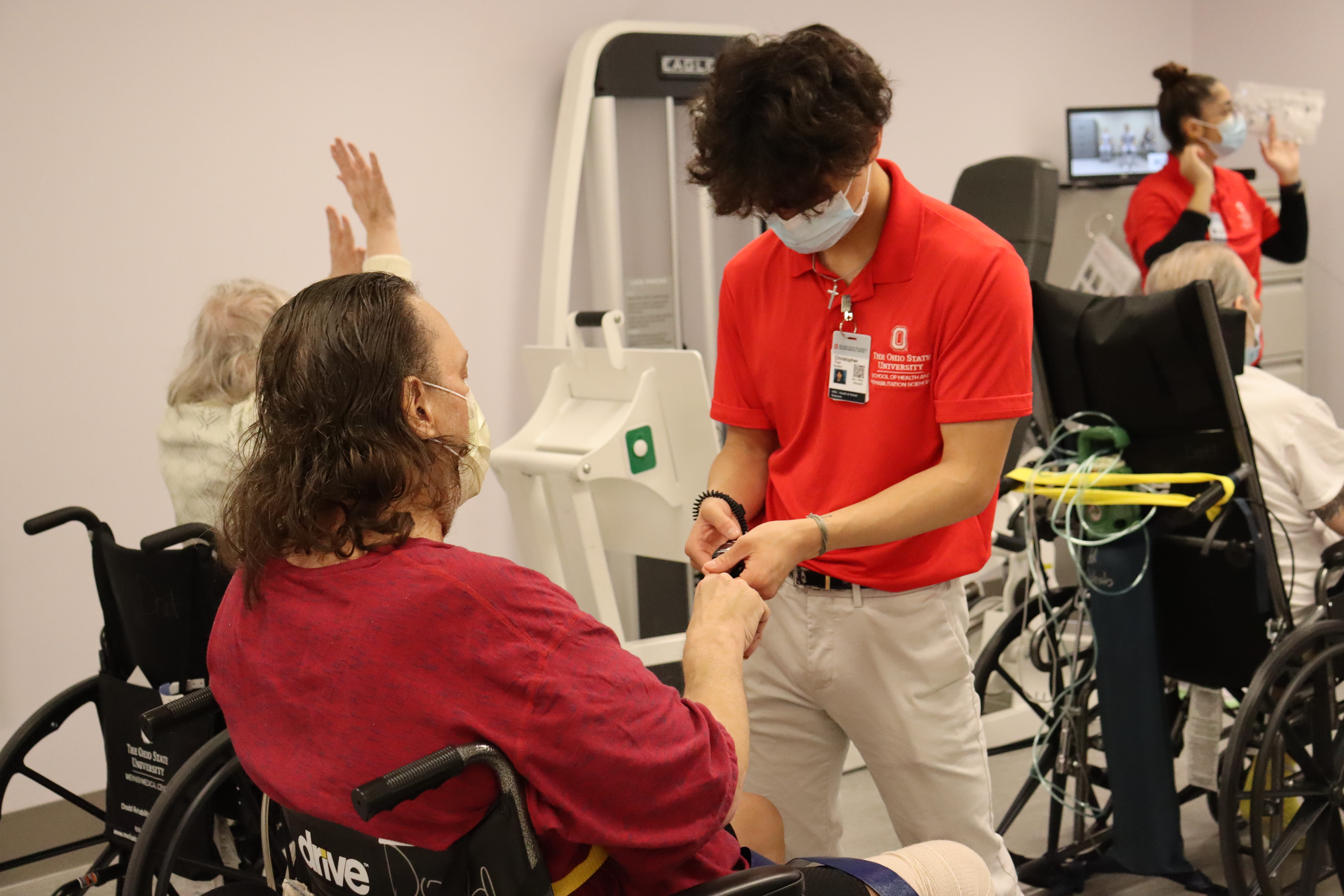 In spring 2023, The Ohio State University School of Health and Rehabilitation Sciences (HRS) launched CARESTREAM, the school’s first independent course of study designed to provide undergraduate students with classroom learning and valuable, early clinical exposure on how they can help reduce patient falls, frailty and functional decline, working directly with patients at The Ohio State University Wexner Medical Center.
In spring 2023, The Ohio State University School of Health and Rehabilitation Sciences (HRS) launched CARESTREAM, the school’s first independent course of study designed to provide undergraduate students with classroom learning and valuable, early clinical exposure on how they can help reduce patient falls, frailty and functional decline, working directly with patients at The Ohio State University Wexner Medical Center.
Still in its pilot phase, CARESTREAM stands for Cultivating Augmented Resilience-Building Efforts and Systems for Transitions, Rehabilitation, Education, Access and Maintenance.
The program’s goal is to provide students with experiential learning and to address critical gaps in the health care system, specifically, improving system workflow by freeing up nurses and other health care providers, says James Crick Jr., DPT, PT, course lead for CARESTREAM. The first course ran in spring, summer and fall 2023, with 30 students having completed the program in fall. Crick says the plan is to expand the course capacity to 46 in spring 2024.
Funded by the Care Innovation and Community Improvement Program, CARESTREAM centers on the critical nationwide problem of patients falling, becoming frail or losing function during or soon after their hospital stay, Crick says.
“The entirety of the program is capacity building,” he says. “Functional decline will affect 30 to 40 percent of the population. That’s more than one in three people coming who will have mobility issues.”
Five of the eight members of the CARESTREAM team are HRS faculty and graduate student assistants; others are College of Medicine and Ohio State Wexner Medical Center employees.
Alongside ensuring patient safety and mobility, CARESTREAM empowers students with a breadth of learning experiences, Crick says. “When I orient the students, I tell them, ‘you are co-creating this program with us’. Because of that, students are empowered to speak openly about the things they find valuable and to also go into their clinicals and find new tasks or new roles they can fill.”
With the endorsement of medical center executive leaders in directorship roles, CARESTREAM partners to place students with managers or directors in acute rehabilitation services, nurse managers in the emergency department and select inpatient units, and with rehabilitation managers in the Ohio State Dodd Hall Rehabilitation Hospital.
A key CARESTREAM element is that students are helping to do especially the nonskilled tasks that relate to helping keep patients moving while they’re in the hospital, says Catherine Quatman-Yates, PT, DPT, PhD, a physical therapist and associate professor in the school’s Division of Physical Therapy.
“Of course, there are many patients who need help to move, and there are patients who just need someone to watch, assist and encourage them to walk,” she says. And, she adds, students engaging with patients who need to move can actually help watch for and prevent delirium, an associated effect of immobility in ICU patients.
Another element of the program is that by students helping to offload the nursing staff with these nonskilled tasks, nurses can focus on providing more mobility supports for the patient, she says.
CARESTREAM student feedback has been overwhelmingly positive, says Crick, with four out of five students saying the clinic experience has been “useful and relevant.” Some of the students said that the course opened their eyes other types of careers in the hospital. “That was really meaningful for us,” Crick says. “For example, if a student didn’t get into the physical therapy program, they could now see what other professions there are to explore.”
Many also noted that the program’s direct patient experience helped them become comfortable communicating with hospital staff and patients, and generally learning how a hospital works. The students leave having a confidence level that even some graduate level students Crick admits have not yet mastered, he says.
The significance of this experience cannot be underestimated, Crick says. “These are our future physicians or our future therapists who unfortunately in the past have been being asked to make decisions about their future professions without knowing what that-day-to-day process looks like.”
CARESTREAM students, in contrast, recognize how a hospital works, he says. “They understand how critical communication is for a multi-disciplinary team in taking care of patients of variable levels of illness and communication ability.”
Other students take the course already knowing they’d like to pursue hospital administration or health care information technology, and find the experience meaningful, Crick says. “Some say, ‘Wow, I could have gone my entire career almost never interacted with a patient. Now I get to see from what it looks to provide care on the front lines.’”
The program has also helped students determine whether a career in health care is even right for them, says Quatman-Yates.
“The reality is that health care isn’t for everyone, and we feel it’s a big win when we can help them rule that out.”
Other positive signs point toward continued growth and possibly HRS recruitment, Crick says, given that there is no other known program funded within an academic medical center partnership similar to Ohio State’s. Student interest in the course is also rapidly growing, he says, as word of mouth spreads from current and past course participants.
HRS is already seeing the CARESTREAM impact. Of the first 30 students who completed the program, eight applied to positions at the medical center, Crick says.
“Certainly, for the health system, that’s meaningful because that means we now have motivated, talented and intelligent students who are entering into the workforce who understand the role they’re being asked to do.”
